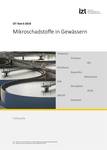Micro-pollutants in water bodies
Abstract
This transformation field analysis was prepared as part of the project "Evolution2Green - Transformation Pathways to a Green Economy: Shaping the Path Change". As one of four studies from the field of raw materials, it examines the transformation field "micro pollutants in water bodies". The paper describes the transformation field and the actors involved. The study identified path dependencies that prevent a transformation towards a sustainable economy and analysed relevant transformation approaches. In many water bodies, micro-pollutants exceed the legally prescribed environmental quality standards. For the reduction of micro-pollutants, both source-oriented and downstream measures are available, each with their specific advantages and disadvantages. However, the measures are differently developed and concretised. While the technologies for a 4th purification stage are de facto fully developed for downstream measures and the main concern here is area-wide implementation, the situation with preventive measures is much more heterogeneous. Many of the approaches have been little developed to date. Source-oriented measures to prevent and reduce micropollutants are confronted with substance- and application-specific path dependencies: Particularly in the case of pharmaceuticals, excretion from the body is a given, so that input into water bodies via wastewater treatment plants is inevitable. Substitution options are not available. This is the case, for example, with many pharmaceuticals. The development of alternatives is usually complex and cost-intensive. Micro-pollutants are disposed of via central sewage treatment plants. Decentralised collection and disposal infrastructures do not exist. Restrictions and bans on use are only possible to a very limited extent with regard to water protection. A change of path presupposes giving greater weight to source-oriented measures by upgrading wastewater treatment plants with a 4th treatment stage ("end-of-pipe"). This includes the implementation of the polluter-pays principle for micro-pollutants: greater consideration of water protection in approval procedures for chemicals and pharmaceuticals, binding instruments for the use of pesticides, and a new pharmaceutical strategy. Only through an efficient combination of the various approaches can the environmental policy objectives be achieved.
